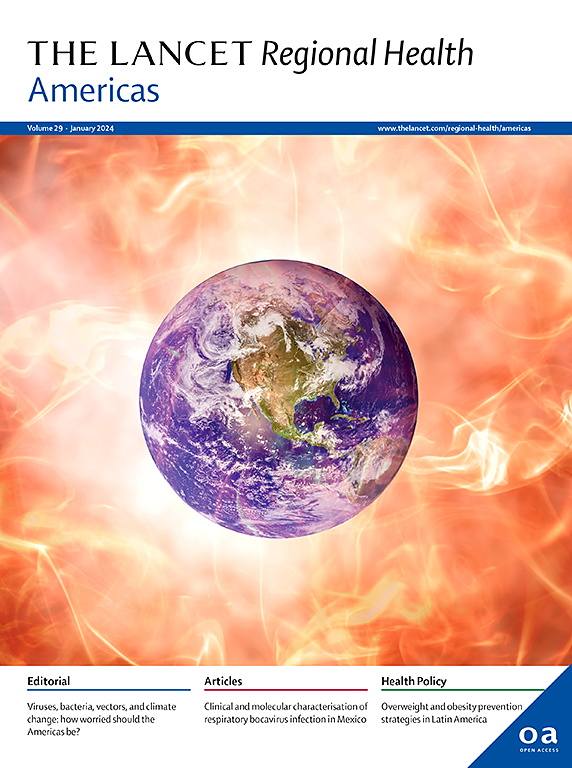Primary health care data-based early warning system for dengue outbreaks: a nationwide case study in Brazil
IF 7
Q1 HEALTH CARE SCIENCES & SERVICES
引用次数: 0
Abstract
Background
Traditional surveillance presents limitations for early outbreak detection. Primary health care (PHC) administrative data applied to syndromic surveillance offers a cost-effective way to integrate early warning systems (EWS). We evaluate the potential of an EWS for dengue outbreaks using PHC data in Brazil.
Methods
We applied the Early Aberration Reporting System (EARS-C1 and EARS-C2) to arbovirus-related PHC encounters from October 1, 2022, to March 1, 2024, to establish an EWS across 5570 municipalities. We assessed EWS timeliness, sensitivity, and positive predictive value (PPV) against fixed-incidence dengue outbreak thresholds.
Findings
Arbovirus-related PHC encounters occurred in 5364 (96.3%) and dengue cases in 5269 (94.6%) Brazilian municipalities. PHC-based warnings anticipated 48.5% (100 cases/100,000 inhabitants), and 68.4% (300/100,000) of outbreaks detected by existing surveillance. Timeliness was higher in municipalities with over 100,000 inhabitants.
Interpretation
The EARS algorithm applied to PHC data anticipated outbreaks up to four weeks before suspected case reporting. Its use of routine data ensures broader coverage and scalability. This study demonstrates the feasibility of integrating PHC data into an EWS for early dengue outbreak detection in Brazil.
Funding
Rockefeller Foundation’s Health Initiative and Fundação de Amparo à Pesquisa do Estado da Bahia, Brazil.
基于初级卫生保健数据的登革热疫情早期预警系统:巴西全国案例研究
传统监测在早期发现疫情方面存在局限性。初级卫生保健(PHC)行政数据应用于综合征监测,为整合早期预警系统(EWS)提供了一种具有成本效益的方法。我们利用巴西PHC的数据评估EWS在登革热暴发中的潜力。方法应用早期异常报告系统(ear - c1和ear - c2)对2022年10月1日至2024年3月1日期间虫媒病毒相关PHC遭遇病例进行监测,在5570个城市建立EWS。我们评估了EWS的及时性、敏感性和针对固定发病率登革热爆发阈值的阳性预测值(PPV)。发现5364例(96.3%)与sarbovirus相关的PHC接触病例和5269例(94.6%)登革热病例。基于初级保健的预警预计现有监测发现的疫情为48.5%(100例/10万居民)和68.4%(300例/10万)。在人口超过10万的城市,及时性更高。应用于初级保健数据的ear算法可在疑似病例报告前4周预测疫情。它对常规数据的使用确保了更广泛的覆盖范围和可扩展性。这项研究证明了将初级保健数据整合到EWS中用于巴西早期登革热疫情检测的可行性。资助洛克菲勒基金会的卫生倡议和巴西巴伊亚州卫生基金会。
本文章由计算机程序翻译,如有差异,请以英文原文为准。
求助全文
约1分钟内获得全文
求助全文
来源期刊

Lancet Regional Health-Americas
Multiple-
CiteScore
8.00
自引率
0.00%
发文量
0
期刊介绍:
The Lancet Regional Health – Americas, an open-access journal, contributes to The Lancet's global initiative by focusing on health-care quality and access in the Americas. It aims to advance clinical practice and health policy in the region, promoting better health outcomes. The journal publishes high-quality original research advocating change or shedding light on clinical practice and health policy. It welcomes submissions on various regional health topics, including infectious diseases, non-communicable diseases, child and adolescent health, maternal and reproductive health, emergency care, health policy, and health equity.
 求助内容:
求助内容: 应助结果提醒方式:
应助结果提醒方式:


